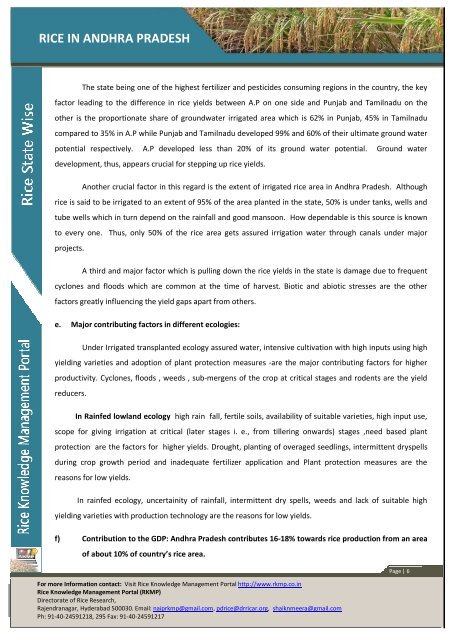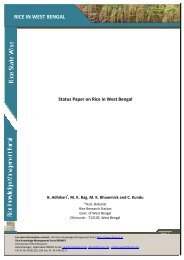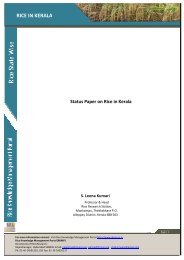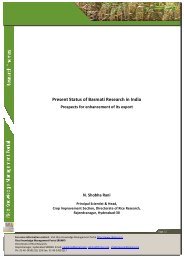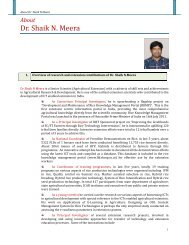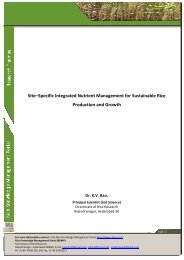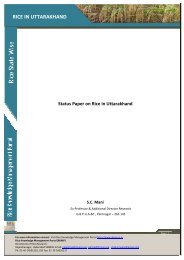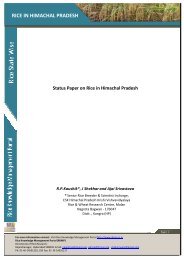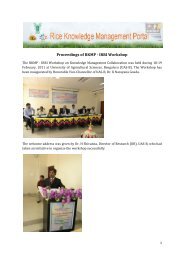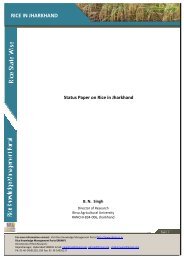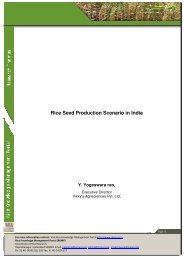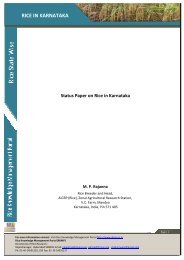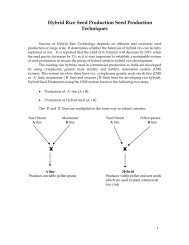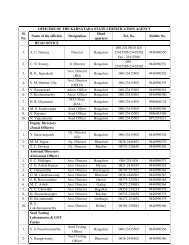RICE IN ANDHRA PRADESH - Rice Knowledge Management Portal
RICE IN ANDHRA PRADESH - Rice Knowledge Management Portal
RICE IN ANDHRA PRADESH - Rice Knowledge Management Portal
You also want an ePaper? Increase the reach of your titles
YUMPU automatically turns print PDFs into web optimized ePapers that Google loves.
<strong>RICE</strong> <strong>IN</strong> <strong>ANDHRA</strong> <strong>PRADESH</strong><br />
The state being one of the highest fertilizer and pesticides consuming regions in the country, the key<br />
factor leading to the difference in rice yields between A.P on one side and Punjab and Tamilnadu on the<br />
other is the proportionate share of groundwater irrigated area which is 62% in Punjab, 45% in Tamilnadu<br />
compared to 35% in A.P while Punjab and Tamilnadu developed 99% and 60% of their ultimate ground water<br />
potential respectively. A.P developed less than 20% of its ground water potential. Ground water<br />
development, thus, appears crucial for stepping up rice yields.<br />
Another crucial factor in this regard is the extent of irrigated rice area in Andhra Pradesh. Although<br />
rice is said to be irrigated to an extent of 95% of the area planted in the state, 50% is under tanks, wells and<br />
tube wells which in turn depend on the rainfall and good mansoon. How dependable is this source is known<br />
to every one. Thus, only 50% of the rice area gets assured irrigation water through canals under major<br />
projects.<br />
A third and major factor which is pulling down the rice yields in the state is damage due to frequent<br />
cyclones and floods which are common at the time of harvest. Biotic and abiotic stresses are the other<br />
factors greatly influencing the yield gaps apart from others.<br />
e. Major contributing factors in different ecologies:<br />
Under Irrigated transplanted ecology assured water, intensive cultivation with high inputs using high<br />
yielding varieties and adoption of plant protection measures -are the major contributing factors for higher<br />
productivity. Cyclones, floods , weeds , sub-mergens of the crop at critical stages and rodents are the yield<br />
reducers.<br />
In Rainfed lowland ecology high rain fall, fertile soils, availability of suitable varieties, high input use,<br />
scope for giving irrigation at critical (later stages i. e., from tillering onwards) stages ,need based plant<br />
protection are the factors for higher yields. Drought, planting of overaged seedlings, intermittent dryspells<br />
during crop growth period and inadequate fertilizer application and Plant protection measures are the<br />
reasons for low yields.<br />
In rainfed ecology, uncertainity of rainfall, intermittent dry spells, weeds and lack of suitable high<br />
yielding varieties with production technology are the reasons for low yields.<br />
f) Contribution to the GDP: Andhra Pradesh contributes 16-18% towards rice production from an area<br />
of about 10% of country’s rice area.<br />
For more Information contact: Visit <strong>Rice</strong> <strong>Knowledge</strong> <strong>Management</strong> <strong>Portal</strong> http://www.rkmp.co.in<br />
<strong>Rice</strong> <strong>Knowledge</strong> <strong>Management</strong> <strong>Portal</strong> (RKMP)<br />
Directorate of <strong>Rice</strong> Research,<br />
Rajendranagar, Hyderabad 500030. Email: naiprkmp@gmail.com, pdrice@drricar.org, shaiknmeera@gmail.com<br />
Ph: 91-40-24591218, 295 Fax: 91-40-24591217<br />
Page | 6


